Sustainable Development and Technological Impact on CO2 Reducing Conditions in Romania
Abstract
:1. Introduction
- Social: organizational impact on employees, community, customers, suppliers, stakeholders, the public, media;
- Economic: financial performance development based on the principles and laws in business;
- Environment: it refers to the organization’s impact on the environment through the processes and activities that they perform [3].

2. CO2 Emissions in Romania and the EU Today
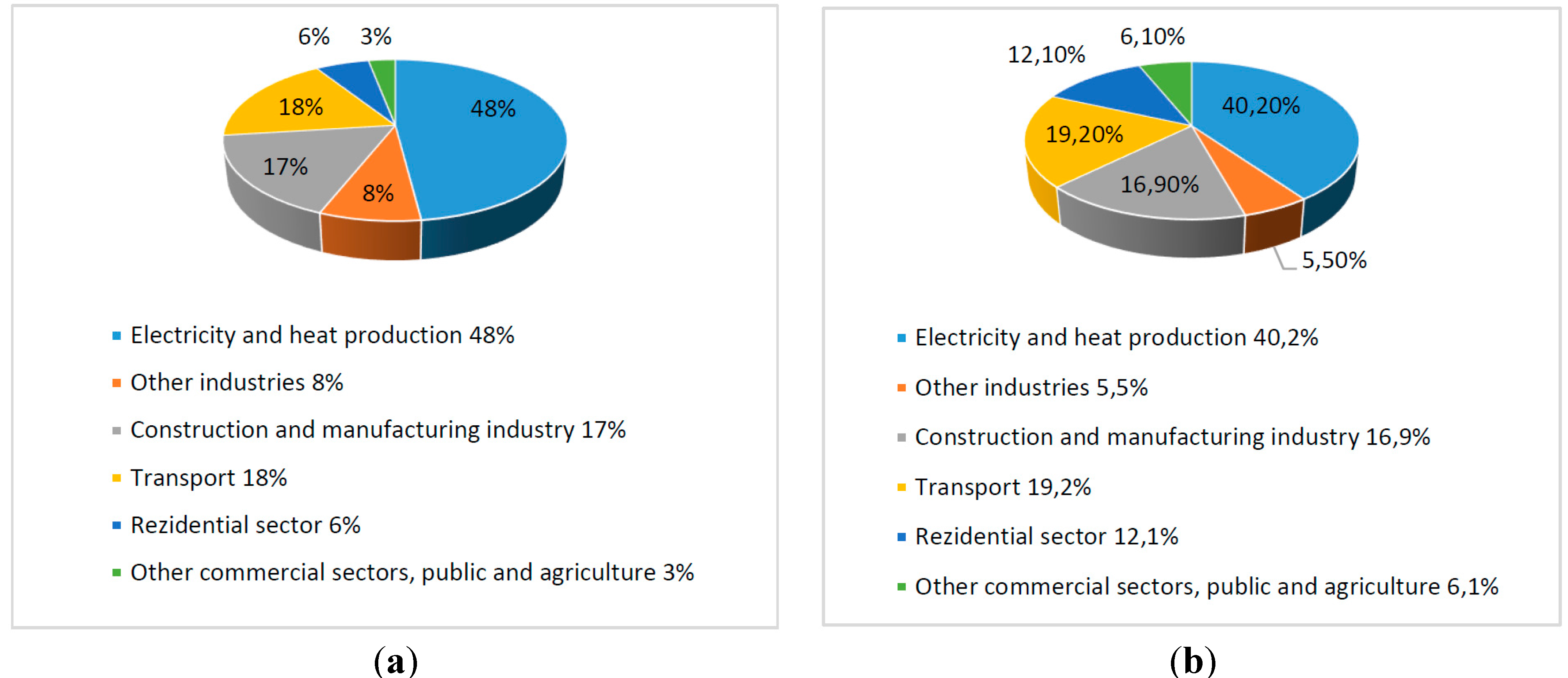
2.1. The Energy Sector
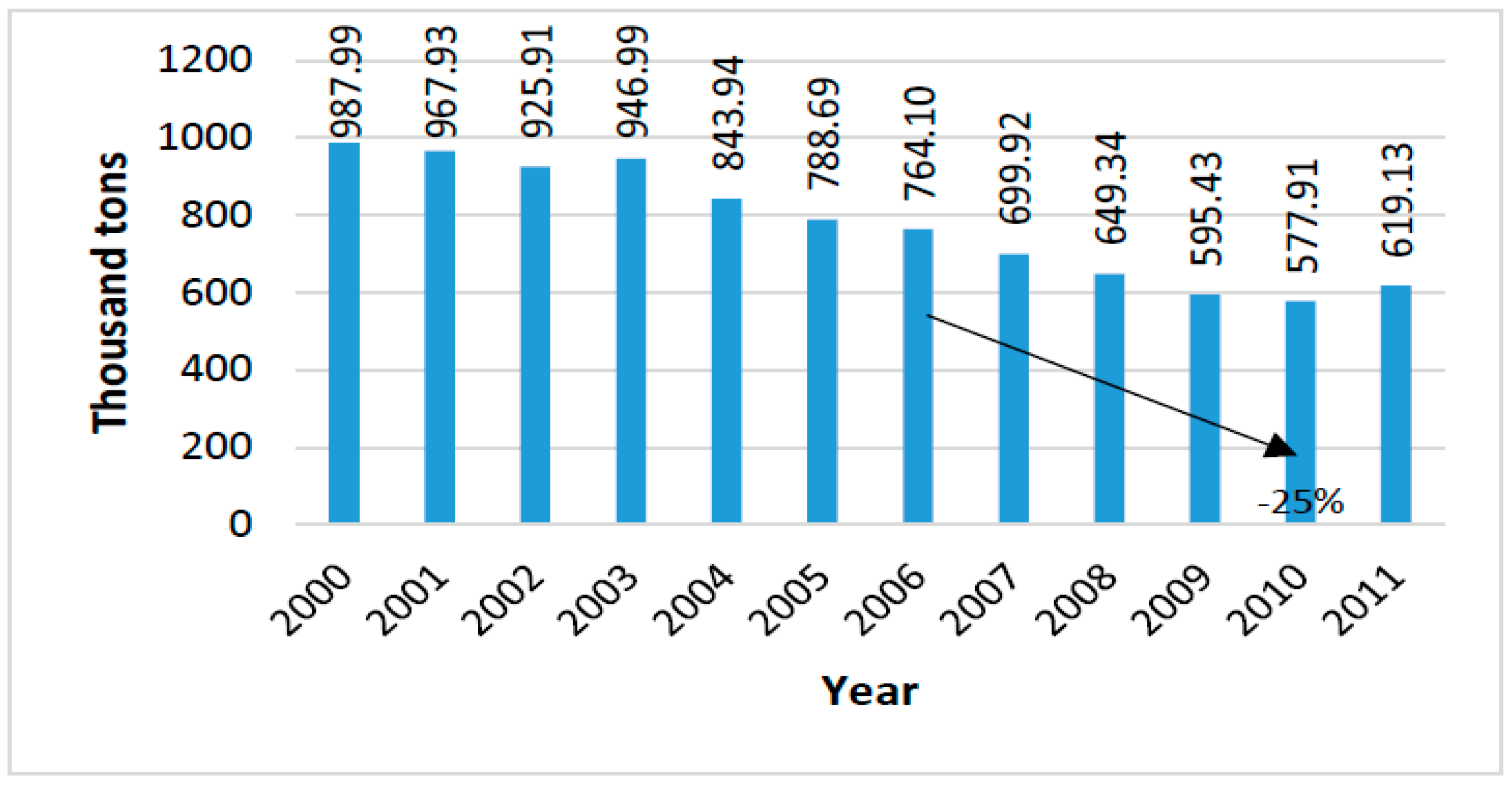
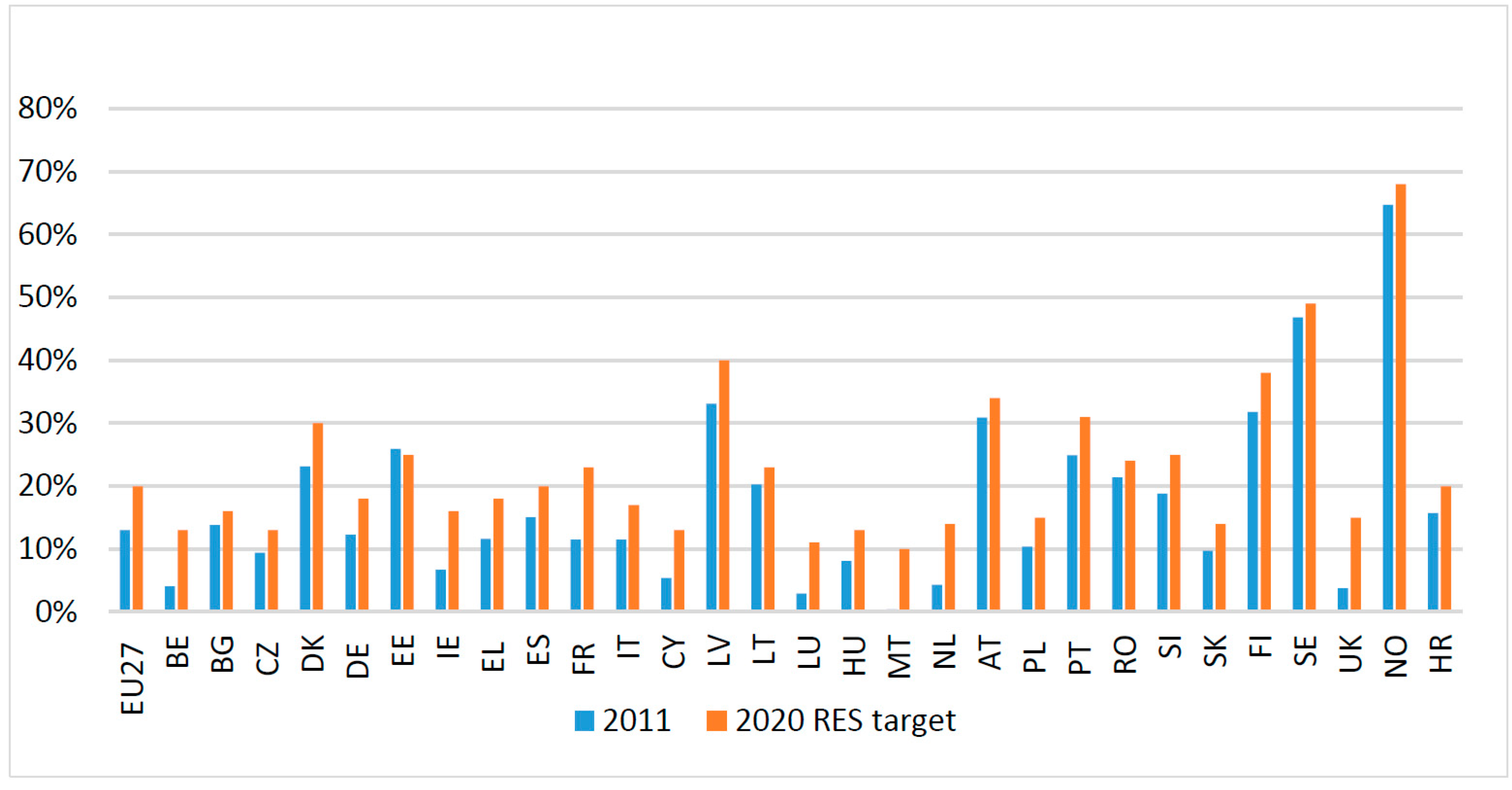
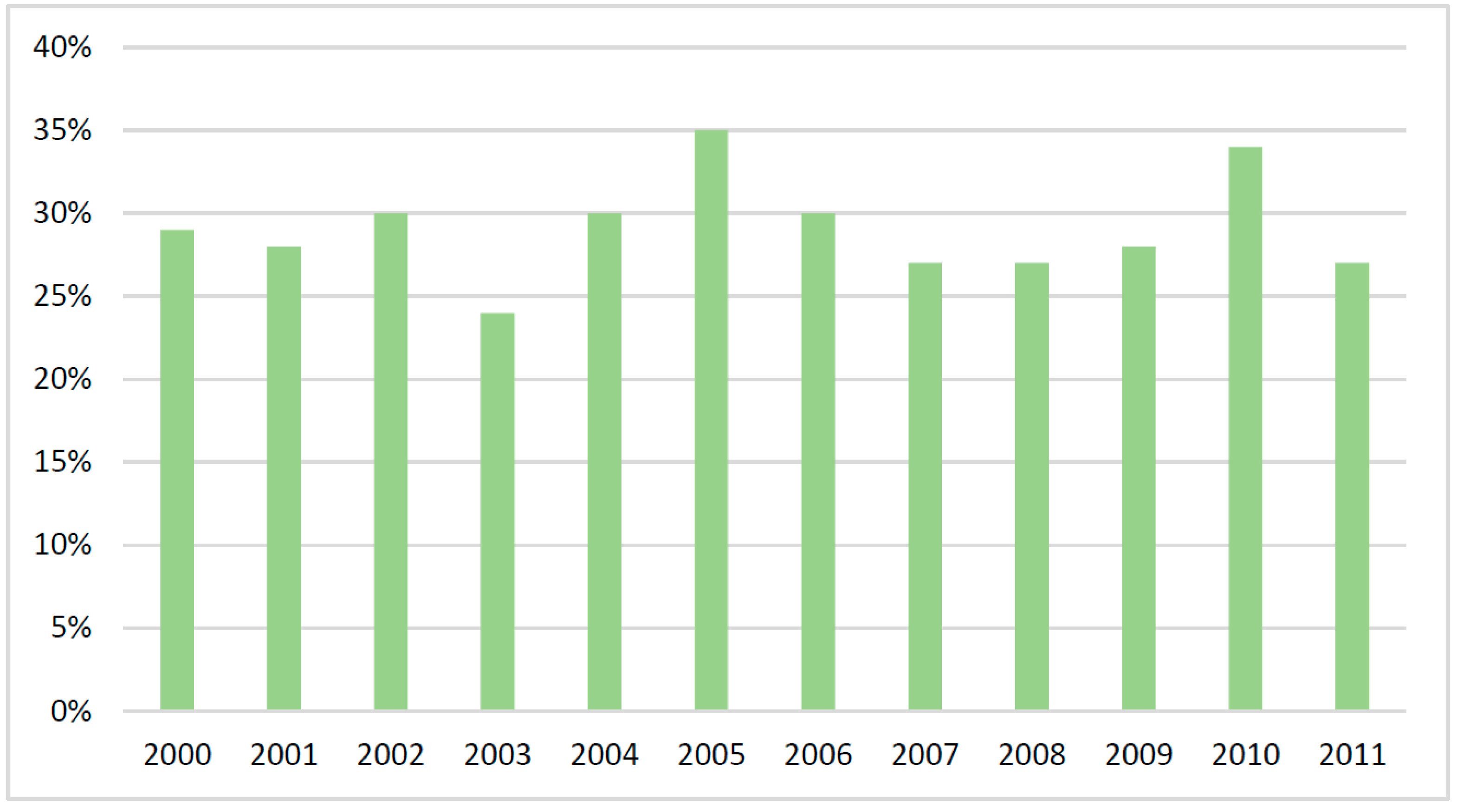
| Renewable Energy Source | Technical Potential [GWh] | Technical Potential [thousand toe] |
|---|---|---|
| Wind | 409,731 | 35,231 |
| Solar thermal | 14,932 | 1284 |
| Solar photovoltaic | 161,929 | 13,923 |
| Biodiesel | 6084 | 523 |
| Bioethanol | 45,461 | 3909 |
| Solid fuel | 71,966 | 6188 |
| Micro hydro | 14,724 | 1266 |
| Geothermal | 279 | 24 |
| Total | 710,103 | 61,058 |
2.2. The Transportation Sector

2.3. The Waste Sector
| MSW (tons) | 2006 | 2007 | 2008 | 2009 | 2010 | 2011 |
|---|---|---|---|---|---|---|
| Collected | 6,334,491 | 6,187,943 | 6,558,342 | 6,264,778 | 5,325,808 | 4,553,300 |
| Recycled | 40,945 | 65,741 | 72,110 | 100,455 | 296,342 | 331,622 |
| MSW recycling rate | 0.65% | 1.06% | 1.10% | 2% | 6% | 7% |
2.4. The Industrial Sector

3. Results and Discussion

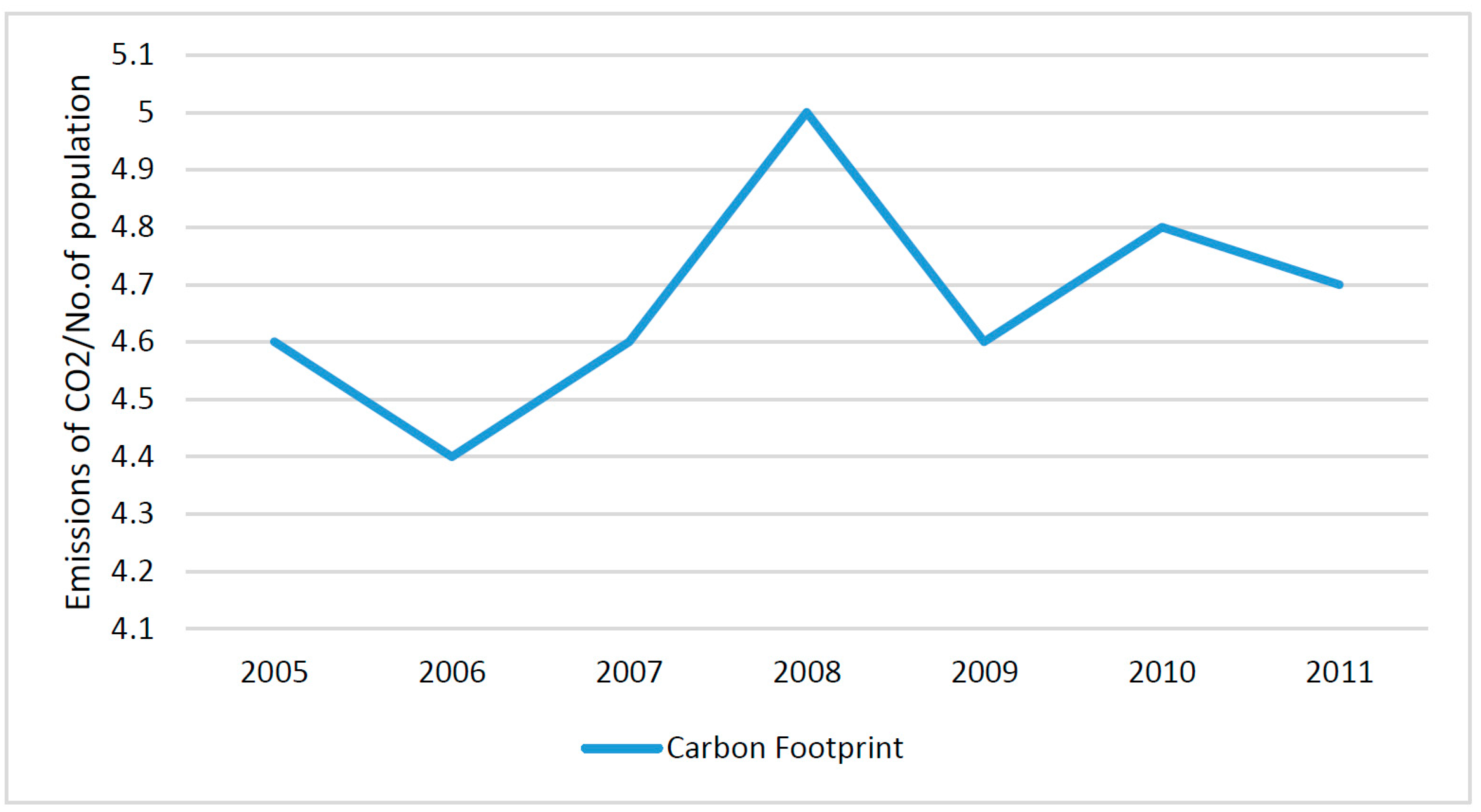
4. A Summary of Findings
- Level of total GHG emissions is lower compared to 2008, but there was a small increase in 2011 (according to Figure 1a);
- In terms of the CO2 emissions in Romania, there are actions to monitor and reduce pollution in excessively polluting sectors (the first three sectors): electricity and heat production, manufacturing industry and transport. For example, Romania’s energy sector emits 8% more CO2, i.e., 48% (According to Figure 2). These actions and strategies mainly refer to the use of renewable sources (subsidized by the government) and to the reduction of polluting factors and their replacement with innovative elements;
- Due to the intensity of rainfall and climate change, the share of electricity from renewable sources of the total electric sector was 27% in 2011, i.e., a lower value than in 2010 when it was 34% (according to Figure 5);
- There are efforts to use bio-fuels and hybrid cars in transportation, reaching a value of 3.55% in 2011, which was a major breakthrough compared to 2006 (according to Figure 6b);
- The waste sector is in an unacceptable situation in comparison with the EU. The expected reduction of landfilling will positively affect the role of MSW sector in the balances of GHG thanks to the decrease of fugitive emissions of methane (according to Figure 7a,b);
- Romania is situated below the EU per capita average amount of MSW generation;
- The industrial sector shows a slight decrease in the number of active companies, and thus there was a slight decrease in the amount of waste generated.
5. Conclusions
Author Contributions
Conflicts of Interest
References
- United Nations Conference on Environment and Development—UNCED. Agenda 21. Available online: http://www.un.org/esa/dsd/agenda21/ (accessed on 2 November 2014).
- Häikiö, L. Institutionalization of Sustainable Development in Decision-Making and Everyday Life Practices: A Critical View on the Finnish Case. Sustainability 2014, 6, 5639–5654. [Google Scholar] [CrossRef]
- European Commission. Available online: http://ec.europa.eu/ (accessed on 10 May 2013).
- McGlade, J.M. State of the Water Environment. In Proceedings of the Informal meeting of Ministers of Environment and Climate Change, Nicosia, Cyprus, 7–8 July 2012.
- Varga, B.O. Electric vehicles, primary energy sources and CO2 emissions: Romanian case study. Energy 2013, 49, 61–70. [Google Scholar] [CrossRef]
- National Institute of Statistics. National Statistical System. Available online: http://www.insse.ro/cms/en (accessed on 2 November 2014).
- International Energy Agency. IEA Statistics. CO2 Emissions from Fuel Combustion, 2013 Edition. Available online: http://www.iea.org/publications/freepublications/publication/co2emissionsfromfuelcombustionhighlights2013.pdf (accessed on 2 November 2014).
- Regional Development Agency. Statistical communications. Available online: http://www.adrcentru.ro/ (accessed on 2 December 2014).
- Covenant of Mayors. Sustainable energy action plans. Available online: http://www.covenantofmayors.eu/ (accessed on 2 December 2014).
- Duflou, J.R.; Sutherland, J.W.; Dornfeld, D.; Hermann, C.; Jeswiet, J.; Kara, S.; Hauschild, M.; Kellens, K. Towards energy and resource efficient manufacturing: A processes and systems approach. CIRP Ann.–Manuf. Technol. 2012, 61, 587–609. [Google Scholar] [CrossRef]
- Yuan, C.; Zhai, Q.; Dornfeld, D. A three dimensional system approach for environmentally sustainable manufacturing. CIRP Ann.–Manuf. Technol. 2012, 61, 39–42. [Google Scholar] [CrossRef]
- MoosaviRad, S.H.; Kara, S.; Hauschild, Z. Long term impacts of international outsourcing of manufacturing on sustainability. CIRP Ann.–Manuf. Technol. 2014, 63, 41–44. [Google Scholar] [CrossRef]
- Paska, J.; Surma, T. Electricity generation from renewable energy sources in Poland. Renew. Energy 2014, 71, 286–294. [Google Scholar] [CrossRef]
- Swider, D.J.; Beurskens, L.; Davidson, S.; Twidell, J.; Pyrko, J.; Pruggler, W.; Auer, H.; Skema, R. Conditions and costs for renewable electricity grid connection: Examples in Europe. Renew. Energy 2008, 33, 1832–1842. [Google Scholar] [CrossRef]
- Ostergaard, P.A. Reviewing optimization criteria for energy systems analyses of renewable energy integration. Energy 2009, 34, 1236–1245. [Google Scholar] [CrossRef]
- Lund, H.; Mathiesen, B.V. Energy system analysis of 100% renewable energy systems—The case of Denmark in years 2030 and 2050. Energy 2009, 34, 524–531. [Google Scholar] [CrossRef]
- Ban, M.; Perkovic, L.; Duic, N.; Penedo, R. Estimating the spatial distribution of high altitude wind energy potential in Southeast Europe. Energy 2013, 57, 24–29. [Google Scholar] [CrossRef]
- Gaigalis, V.; Markevicius, A.; Katinas, V.; Skema, R. Analysis of the renewable energy promotion in Lithuanian compliance with the European Union strategy and policy. Renew. Sust. Energ. Rev. 2014, 35, 422–435. [Google Scholar] [CrossRef]
- European Commission. Europe 2020 Indicators—Climate Change and Energy; The Commission to the European Parliament and the Council: Bruxelles, Belgium, 2014. [Google Scholar]
- Dusmanescu, D.; Andrei, J.; Subic, J. Scenario for implementation of renewable energy sources in Romania. Procedia Econ. Financ. 2014, 8, 300–305. [Google Scholar] [CrossRef]
- Ryu, B.Y.; Jung, H.J.; Bae, S.H. Development of a corrected average speed model for calculating carbon dioxide emissions per link unit on urban roads. Transp. Res. Part D Transp. Environ. 2015, 34, 245–254. [Google Scholar] [CrossRef]
- Park, M.S.; Joo, S.J.; Park, S.U. Carbon dioxide concentration and flux in an urban residential area in Seoul, Korea. Adv. Atmos. Sci. 2014, 31, 1101–1112. [Google Scholar] [CrossRef]
- Rada, E.C. Sustainable city and urban air pollution. WIT Trans. Ecol. Environ. 2014, 191, 1369–1380. [Google Scholar]
- Kheirbek, I.; Ito, K.; Neitzel, R.; Kim, J.; Johnson, S.; Ross, Z.; Eisl, H.; Matte, T. Spatial variation in environmental noise and air pollution in New York City. J. Urban Health 2014, 91, 415–431. [Google Scholar] [CrossRef] [PubMed]
- Istrate, I.A.; Oprea, T.; Rada, E.C.; Torretta, V. Noise and air pollution from urban traffic. WIT Trans. Ecol. Environ. 2014, 191, 1381–1389. [Google Scholar]
- Eurostat Statistics. Available online: http://epp.eurostat.ec.europa.eu/ (accessed on 2 December 2014).
- Eurostat Statistics. Available online: http://ec.europa.eu/energy/observatory/trends_2030/doc/trends_to_2050_update_2013.pdf (accessed on 2 December 2014).
- Fujii, M.; Fujita, T.; Ohnishi, S.; Yamaguchi, N.; Yong, G.; Park, H.S. Regional and temporal simulation of a smart recycling system for municipal organic solid wastes. J. Clean Prod. 2014, 78, 208–215. [Google Scholar] [CrossRef]
- Ionescu, G.; Stefani, P. Environmental assessment of waste transport and treatment: A case study. WIT Trans. Ecol. Environ. 2014, 180, 175–185. [Google Scholar]
- Panepinto, D.; Genon, G. Carbon dioxide balance and cost analysis for different solid waste management scenarios. Waste Biomass Valoriz. 2012, 3, 249–257. [Google Scholar] [CrossRef]
- Rada, E.C.; Squazardo, L.; Ionescu, G.; Badea, A. Economic viability of SRF co-combustion in cement factory. UPB Sci. Bull. Serie D 2014, 76, 199–206. [Google Scholar]
- Ghinea, C.; Petraru, M.; Bressers, H.T.A.; Gavrilescu, M. Environmental evaluation of waste management scenarios—Significance of the boundaries. J. Environ. Eng. Landsc. 2012, 20, 76–85. [Google Scholar] [CrossRef]
- Negoi, R.M.; Ragazzi, M.; Apostol, T.; Rada, E.C.; Marculescu, C. Bio-drying of Romanian Municipal Solid Waste: An analysis of its viability. UPB Sci. Bull. Serie C 2009, 71, 193–204. [Google Scholar]
- Government of Romania—Ministry of Foreign Affairs. National Report 2013. Evaluation of the impact of reducing emissions of greenhouse gases on the Romanian economy. Available online: http://ec.europa.eu/europe2020/pdf/nd/nrp2012_romania_en.pdf (accessed on 2 December 2014).
- Wadim, S.; Štepán, K.; Evgeny, L. Energy Economics and Policy of Renewable Energy Sources in the European Union. Int. J. Energy Econ. Policy 2013, 3, 333–340. [Google Scholar]
© 2015 by the authors; licensee MDPI, Basel, Switzerland. This article is an open access article distributed under the terms and conditions of the Creative Commons Attribution license (http://creativecommons.org/licenses/by/4.0/).
Share and Cite
Cioca, L.-I.; Ivascu, L.; Rada, E.C.; Torretta, V.; Ionescu, G. Sustainable Development and Technological Impact on CO2 Reducing Conditions in Romania. Sustainability 2015, 7, 1637-1650. https://doi.org/10.3390/su7021637
Cioca L-I, Ivascu L, Rada EC, Torretta V, Ionescu G. Sustainable Development and Technological Impact on CO2 Reducing Conditions in Romania. Sustainability. 2015; 7(2):1637-1650. https://doi.org/10.3390/su7021637
Chicago/Turabian StyleCioca, Lucian-Ionel, Larisa Ivascu, Elena Cristina Rada, Vincenzo Torretta, and Gabriela Ionescu. 2015. "Sustainable Development and Technological Impact on CO2 Reducing Conditions in Romania" Sustainability 7, no. 2: 1637-1650. https://doi.org/10.3390/su7021637
APA StyleCioca, L.-I., Ivascu, L., Rada, E. C., Torretta, V., & Ionescu, G. (2015). Sustainable Development and Technological Impact on CO2 Reducing Conditions in Romania. Sustainability, 7(2), 1637-1650. https://doi.org/10.3390/su7021637










